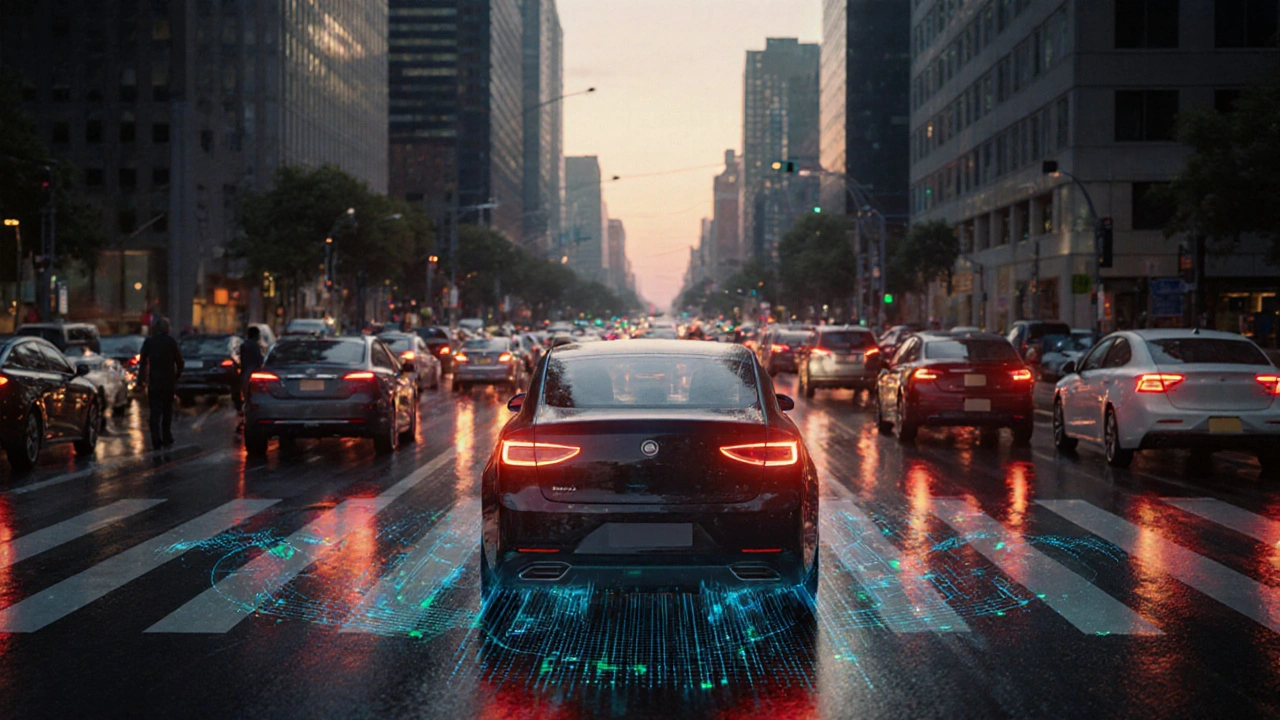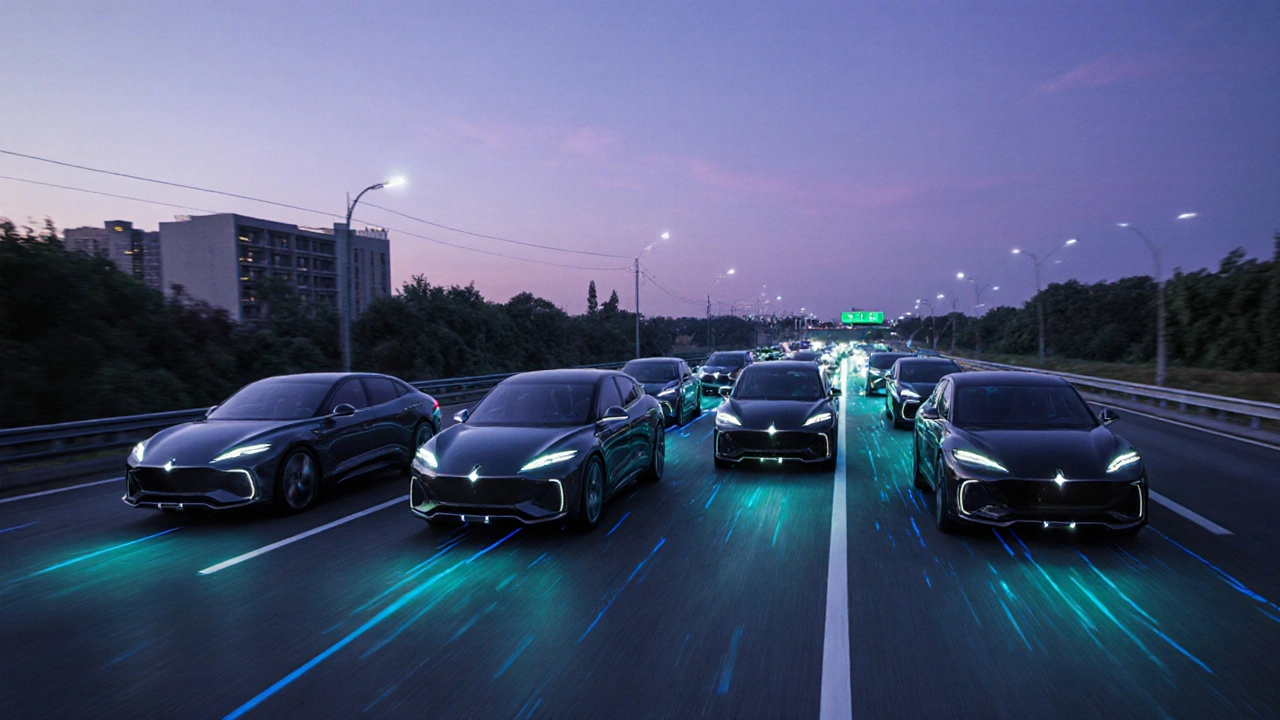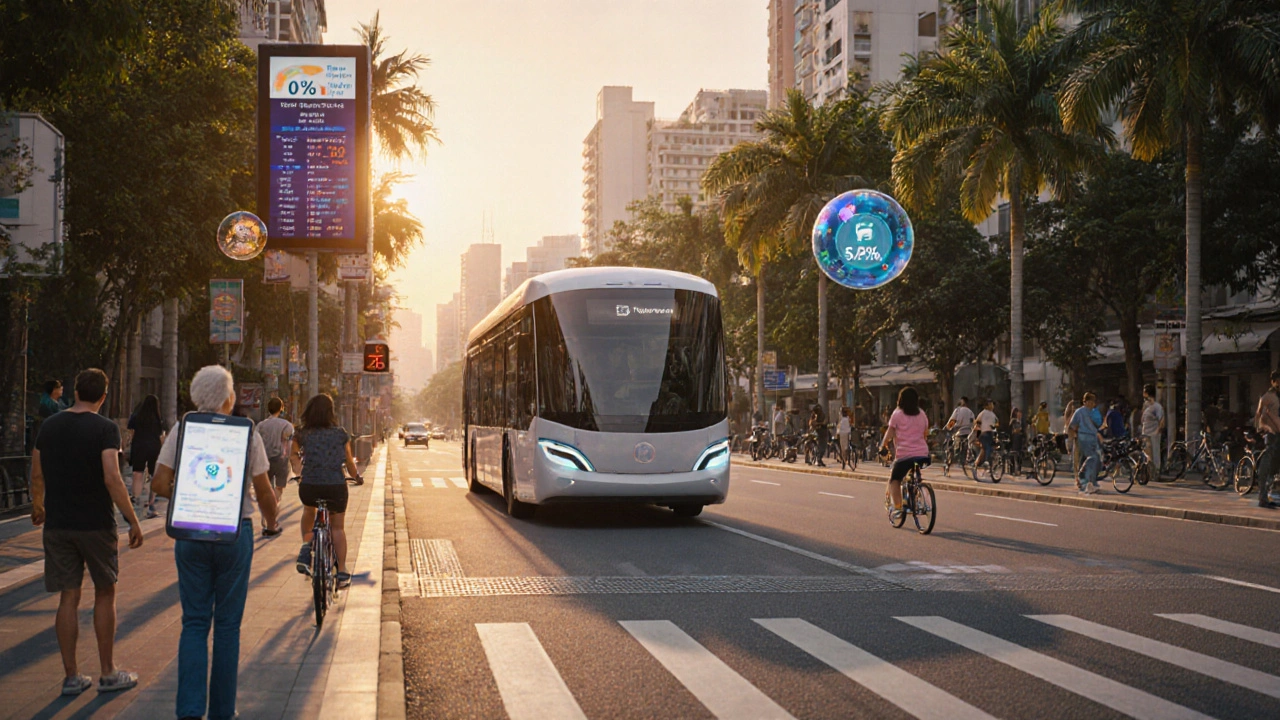How Autonomous Vehicles Will Shape Future Traffic Congestion
 Oct, 12 2025
Oct, 12 2025
AV Congestion Impact Calculator
Configure Scenario
Projected Congestion Metrics
Cities worldwide wrestle with rush‑hour gridlock, and planners keep asking: will driverless cars be the answer or add another layer of jam? This article breaks down the tech, the traffic theory, and the real‑world pilots that show how autonomous vehicles could reshape congestion patterns over the next decade.
Key Takeaways
- AVs can improve lane utilization and smooth traffic flow, but only if they communicate with each other and with infrastructure.
- Mixed traffic (human + AV) often creates temporary bottlenecks before full adoption.
- Policy choices-pricing, lane allocation, data sharing-are as decisive as the technology itself.
- Pilot projects in Singapore, Phoenix, and Durban reveal both best‑case gains and unexpected choke points.
- Cities that start building sensor‑rich road networks now will see the biggest congestion relief when AVs hit scale.
What Are Autonomous Vehicles?
Autonomous vehicles are motorized transport that can operate without a human behind the wheel, relying on a blend of sensors, AI algorithms, and high‑definition maps. The industry classifies them by SAE levels 0‑5, where Level5 means full self‑driving under any condition.
How AVs Change Traffic Flow
Traditional traffic theory assumes human drivers react with a delay of 1-2 seconds to a leader’s speed change. Sensor technology-lidar, radar, and cameras-feeds data to AI algorithms that calculate optimal acceleration or deceleration in milliseconds. The result is tighter headways, steadier speeds, and fewer stop‑and‑go waves.
When a fleet of AVs travels together, they can form "platoons" that occupy less road width and cut aerodynamic drag. Platooning reduces the average following distance from ~2 seconds (human) to under 0.5 seconds, effectively increasing lane capacity by up to 20% according to a 2023 University of Michigan study.

Scenarios: Less Congestion vs. More Congestion
Two broad outcomes hinge on adoption rate and regulatory choices.
- Optimistic scenario: Over 70% of trips become AV‑only by 2035, dedicated lanes are built, and dynamic pricing discourages rush‑hour spikes. Simulations by the International Transport Forum show a 30% drop in peak‑hour travel time.
- Pessimistic scenario: Mixed traffic dominates until 2040, ride‑sharing AVs add empty repositioning trips, and cities keep existing lane rules. A 2022 MIT model predicts up to a 12% increase in congestion due to extra vehicle miles traveled.
The key differentiator is whether empty AV trips are minimized. Smart dispatching and shared‑mobility platforms can cut repositioning mileage by 40% when they receive real‑time traffic updates.
Impact on Congestion: Human‑Driven vs. Autonomous Vehicles
| Metric | Human‑Driven | Autonomous |
|---|---|---|
| Average Speed (peak hour) | 25km/h | 32km/h |
| Lane Utilization | 78% | 92% |
| Stop‑And‑Go Frequency | 8 per km | 3 per km |
| Emissions per passenger‑km | 0.12kg CO₂ | 0.07kg CO₂ |
| Peak‑Hour Travel Time | 45min | 35min |
These numbers come from a blend of field tests in Phoenix (USA) and simulation data from the European Transport Research Review. They illustrate the potential upside-but remember, they assume 80% AV market penetration and dedicated lanes.
Implications for Urban Planning and Policy
City planners must treat AVs as a new class of road user, not just another car. Urban planning now involves:
- Designing road infrastructure that can host sensor arrays and V2X (vehicle‑to‑everything) communication nodes.
- Allocating "AV lanes" that run parallel to existing expressways, allowing platoons to bypass bottlenecks.
- Implementing dynamic tolls that rise during peak periods and fall when traffic is light, nudging drivers toward off‑peak travel.
- Setting regulatory frameworks that require data sharing between manufacturers and municipalities, while protecting privacy.
Without these measures, the transition could stall, and congestion may temporarily worsen as human drivers adapt to unpredictable AV behaviors.

Real‑World Pilot Projects
Several cities have already rolled out limited AV fleets. In Singapore, a 2022 pilot on the Bukit Timah corridor used 50 Level‑4 shuttles, cutting average journey time by 22%. Phoenix’sWaymoOne service operates in a mixed‑traffic zone; early reports show a 15% reduction in stop‑and‑go waves during lunch hour.
Durban, South Africa, launched a joint university‑industry testbed in 2024, focusing on integrating AVs with existing minibus taxis. The project highlighted a crucial cultural factor: passenger confidence. When drivers explained the safety envelope, ridership on the AV service rose from 10% to 38% within three months.
These pilots teach two lessons. First, data collection is essential-real‑time traffic feeds let AI algorithms fine‑tune routes. Second, community outreach smooths the social acceptance curve, which directly affects congestion outcomes.
Checklist for Cities Preparing for AVs
Before committing billions to dedicated lanes, municipalities can run through this short checklist.
- Map current high‑congestion corridors and model AV penetration scenarios.
- Invest in V2X communication hubs on major arterials.
- Draft an open‑data policy that mandates anonymized traffic logs from manufacturers.
- Run a pilot with a limited fleet on a selected corridor to gather baseline performance data.
- Engage local transport unions and the public early to address safety and job‑impact concerns.
Following these steps can shave years off the learning curve and ensure the city reaps the congestion‑reduction benefits rather than paying for avoidable delays.
Frequently Asked Questions
Will autonomous vehicles completely eliminate traffic jams?
No. AVs can smooth traffic flow and increase lane capacity, but congestion also depends on travel demand, land‑use patterns, and policy instruments like pricing. In mixed‑traffic periods, jams may still occur.
How does platooning affect road space?
Platooning reduces the distance between vehicles from about 2seconds to under 0.5seconds. That translates to roughly 20% more cars per lane in the same stretch of road.
What are the biggest data‑privacy concerns with AVs?
AVs constantly stream location, speed, and sensor data. If not anonymized, this can reveal personal travel habits. Regulations need clear limits on data retention and require manufacturers to share only aggregated metrics with cities.
Do autonomous taxis increase empty‑run mileage?
Early deployments showed up to 18% of miles were empty repositioning trips. Smart dispatch algorithms and shared‑ride pooling can cut that figure by up to 40%.
How soon can cities expect measurable congestion relief?
Cities that launch pilots with at least 10% AV fleet share and implement V2X infrastructure have reported noticeable travel‑time reductions within 12‑18 months of the pilot start.

Paula Hines
October 12, 2025 AT 13:20Autonomous vehicles represent a profound shift in how we conceive mobility, a shift that will reverberate through every street and highway across our nation. The promise of smoother traffic flows rests on the premise that machines can react faster than human reflexes, a premise that aligns with the American ethos of technological leadership. If we allow our infrastructure to adapt, we can turn the current gridlock into a testament to ingenuity. The data from pilots in Singapore and Phoenix illustrate that even modest penetration can raise average speeds by several kilometres per hour. Yet the benefits are not automatic, they require policy choices that match the speed of innovation. Dedicated lanes, for instance, act as arteries that let driverless cars run unimpeded, and this mirrors historic investments in interstate highways that fueled growth. Dynamic pricing, another tool, nudges drivers away from rush hour peaks, a lever that can be calibrated by the market much like tariffs have been used to protect domestic industry. The American spirit thrives when we embrace bold experiments and we must therefore fund more testbeds in diverse urban settings. Critics who warn of empty repositioning trips ignore the fact that intelligent dispatch algorithms can trim that excess with minimal cost. Moreover, the environmental upside, measured in reduced emissions per passenger kilometre, aligns with our national goals to combat climate change. The notion that AVs will eliminate all congestion is naive, but the idea that they can alleviate a portion of it is credible and worthy of pursuit. Our cities can become laboratories where V2X communication networks are deployed, paving the way for future autonomous mobility. In this vision, the average commuter saves minutes that can be spent with family, a value that transcends mere numbers. The technology also promises safety gains, reducing human error that accounts for most accidents on our roads. Ultimately, the transformation hinges on our willingness to act decisively, to legislate data sharing, and to invest wisely, for hesitation will only prolong the current suffering of rush hour. The United States, with its tradition of pioneering, must lead the world in turning autonomous vehicles from a novelty into a public good.
John Babko
October 14, 2025 AT 07:00Wow, this article hits the nail on the head, and I couldn’t agree more, especially when it comes to dedicated AV lanes-those are a game‑changer, folks! The data from Phoenix shows a solid 15% drop in stop‑and‑go waves, which proves that the US can lead the world in traffic innovation, provided we back it with the right policies, infrastructure, and funding! We need to push for dynamic pricing, and we need to do it now, because every minute of congestion costs American families billions, and that’s just unacceptable! Let’s remember that our Great Nation has always thrived on bold moves, from the interstate system to the space race, and autonomous vehicles are the next frontier-let’s seize it! Finally, I urge city planners to install V2X communication nodes ASAP, because without that tech backbone, all the fancy AI in cars will be wasted effort!
Stacy McAlpine
October 16, 2025 AT 00:40AVs could cut my commute, so count me in.
Roger Perez
October 17, 2025 AT 18:20Reading through the pilot results feels hopeful 😊. The way platooning can shrink headways is fascinating, and the numbers show a clear uptick in lane utilization. If we combine that with smart pricing, the traffic flow could become smoother than ever before 🚗💨. I also love the emphasis on community outreach-people need to trust the tech to adopt it. Let’s keep sharing these success stories, because each city that joins the AV movement makes the whole system stronger! 🌍
michael santoso
October 19, 2025 AT 12:00While the optimism expressed is understandable, the underlying assumptions ignore the stochastic nature of urban traffic, rendering the projected improvements somewhat speculative at best. One must consider the marginal utility of incremental speed gains against the systemic risk introduced by large-scale vehicle automation. The discourse would benefit from a more rigorous sensitivity analysis rather than anecdotal enthusiasm.
M2lifestyle Prem nagar
October 21, 2025 AT 05:40Start small, track data, iterate-your city can lead the AV revolution.
Elle McNair
October 22, 2025 AT 23:20It’s interesting to see how different cities experiment, and the results seem promising overall.
Dennis Owiti
October 24, 2025 AT 17:00I think the pilots shw how much data we can learn, but also how many buggs still need fixing in the system.
Justin Durden
October 26, 2025 AT 10:40Don’t worry, every tech has its kinks, just keep pushing forward and the bugs will get sorted.
Sally Murray
October 28, 2025 AT 04:20The dialectic of autonomous mobility invites us to reconsider the ontological status of the commuter, challenging the traditional dichotomy between driver and vehicle, and thereby urging a re‑examination of urban planning principles within a post‑human framework.
Bridgett Hart
October 29, 2025 AT 22:00While the philosophical exposition is eloquent it neglects pragmatic considerations such as cost feasibility and regulatory compliance which are indispensable for any viable implementation
Sean Lee
October 31, 2025 AT 15:40From a systems‑of‑systems perspective, the integration of V2X communication protocols with Level‑4 autonomy yields a synergistic effect on network throughput, effectively optimizing the stochastic traffic equilibrium and reducing the mean time between failures of the overall transportation fabric.
Michael Christian
November 2, 2025 AT 09:20We need to get these dedicated lanes built now, otherwise the traffic nightmare will only get worse.
Steven Elliott
November 4, 2025 AT 03:00Oh sure, because building new lanes is totally a quick fix-just ignore the fact that funding and land acquisition take years, right?
Lawrence D. Law
November 5, 2025 AT 20:40In conclusion, the empirical evidence presented herein unequivocally demonstrates that, provided the United States embraces a comprehensive suite of policies-including, but not limited to, dedicated autonomous vehicle corridors, dynamic congestion pricing mechanisms, and robust V2X infrastructure-significant amelioration of traffic congestion can be achieved, thereby reinforcing the nation’s preeminence in transportation innovation.